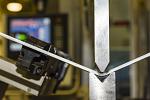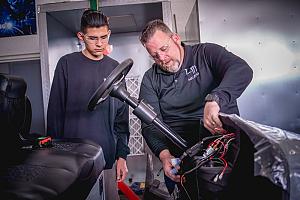- FMA
- The Fabricator
- FABTECH
- Canadian Metalworking
Categories
- Additive Manufacturing
- Aluminum Welding
- Arc Welding
- Assembly and Joining
- Automation and Robotics
- Bending and Forming
- Consumables
- Cutting and Weld Prep
- Electric Vehicles
- En Español
- Finishing
- Hydroforming
- Laser Cutting
- Laser Welding
- Machining
- Manufacturing Software
- Materials Handling
- Metals/Materials
- Oxyfuel Cutting
- Plasma Cutting
- Power Tools
- Punching and Other Holemaking
- Roll Forming
- Safety
- Sawing
- Shearing
- Shop Management
- Testing and Measuring
- Tube and Pipe Fabrication
- Tube and Pipe Production
- Waterjet Cutting
Industry Directory
Webcasts
Podcasts
FAB 40
Advertise
Subscribe
Account Login
Search
Fabricate, powder coat, screen print—done
Why bringing screen printing in-house makes sense for some fabricators

A Gantt chart—a bar graph showing how long each process really takes—can be revealing for a job shop. Depending on how a fabricator develops the chart, several areas jump out. The most blatant is queue time. In a batch-production environment, sheet metal parts can spend a lot of time sitting on the floor or in racks, waiting for bending, welding, deburring, and other processes. Actual processing time at a workstation may take only several hours, but it can take days for that part to make it through the shop.
So the job shop changes work flow, reduces setup time and batch sizes, and products begin flowing. But then the Gantt chart reveals yet another bottleneck. A job shop may be able to process a part in just a few days, but it still takes time to send that part for outside processing. To reduce this time, a job shop has two options: It can either work with suppliers to shorten turnaround time, or bring the process in-house.
The latter has become more prevalent in recent years. Not only can bringing certain processes in-house shorten turnaround time and support lean part flow, it also offers a potential revenue stream and broader customer base. Processes like machining, wet painting, and powder coating fall into this camp, as has another manufacturing step required for many sheet metal parts: screen printing.
With any new process comes growing pains and, let’s be honest, potential failure. Customer rejects are expensive and can damage a contract sheet metal fabricator’s credibility. A shop may have a reputation for beautiful welds or complex forming, but none of it matters to customers if they receive parts with coating that’s flaking off. The same thinking applies to screen printing. A control panel may have perfectly cut corners and fit like a glove in final assembly, but that doesn’t really matter to customers if the screen-printed lettering is incorrect, misaligned, or smudged.
Allentown, Pa.-based Vastex International performs extensive screen printing on sheet metal, and not just because it’s more efficient and less expensive than outsourcing the process. The manufacturer makes screen printing machines mainly for companies in the textile business, but some of its customers screen-print on sheet metal and other hard surfaces. If its customers screen-print, it stands to reason that Vastex should screen-print too.
As company sources pointed out, screen printing sheet metal is similar to screen printing T-shirts and other garments—the fundamental process is the same—but fabricators do have some unique factors to consider.
Process Basics
Screen printing is often called silk-screen printing, and for good reason. Several thousand years ago the Japanese and Chinese developed wooden frames to support a stencil that was glued onto a woven fabric, usually silk. Today screens don’t use silk but instead threads of man-made materials like steel, nylon, and polyester.
Although the screen material has changed, the basic idea behind the process really hasn’t. It uses a positive, a black image of what will be printed. Today screen-makers use Publisher® or Adobe® Illustrator® to draw and finalize the image, then ink-jet-print that image onto a vellum coated with a chemical that holds the ink and prevents it from running off the page.
The screen, which acts as a precision stencil, is made by pulling a mesh taut over a frame. Once ready for use, the mesh is degreased and cleaned. To make a screen, the technician coats both sides of the mesh with emulsion. The vellum positive is aligned and taped to the mesh, which then is exposed to light. The positive blocks the light exposure over the image. After exposure, the area blocked by the positive washes away, revealing the stencil.
“Everything the light hits is cured. Everything the light doesn’t hit is water-soluble, and you can wash it out in the sink,” said Mark Clewell, Vastex’s senior sales technician.
To perform the actual screen print, the technician cleans the part, fixtures it in place, aligns the screen on top, applies ink on the screen, and forces ink through the mesh with a squeegee. He then sets the part to dry or speeds the process by sending it through an oven.
Do You Really Need to Make Screens?
As Vastex President Mark Vasilantone explained, most fabricators who hesitate bringing screen printing in-house do so because of the screen itself. “The scariest part of the process, and rightfully so because it’s the most difficult part, is making the screen,” he said. “It ends up being the most time-consuming as well. Consider a fabricator that makes two prints for several repeatedly ordered products—say a control panel face for one part, and emergency shutoff text for another component—and that’s really it. Why bother getting into screen making?”
He added that for many it may make more sense, at least at first, to keep outsourcing the screen-making process, but bring the screen printing itself in-house.
Screen Tension, Mesh, and Position
Sheet metal and other hard surfaces allow for screen printing extremely fine detail, simply because the surface is denser and smoother than the woven threads of a garment. But with fine detail comes its own challenges.
Images with fine lines and other intricate details usually require a screen with a fine mesh positioned very close to the workpiece surface. The distance between the screen and workpiece is called the off-contact gap. When the technician (or semiautomated machine) drags the squeegee across the screen surface, the screen flexes down, across this gap, until it contacts the workpiece, and ink transfers through the tiny holes of the fine mesh. After the squeegee passes, the screen flexes back up to its original position.
This sequence helps explain how and why the process variables interact the way they do. A larger logo requires a larger screen frame, which in turn requires higher screen tension. If the screen isn’t pulled tight, then the squeegee will stretch and drag the screen during the stroke. This is called mesh crawl, and it effectively smudges or blurs the printed image. The tighter the screen tension (within limits, of course), the less the screen will stretch, and the more precise and detailed the print can be.
On the other hand, a highly tensioned screen requires a flat, defect-free workpiece surface. Say a batch of sheets has the occasional trace of weld spatter. That trace may be enough to rip and ruin a highly tensioned screen. So in this case, a slightly looser screen may suit. This in turn calls for a slightly larger off-contact gap between the screen and the workpiece.
“The off-contact gap varies anywhere from 1⁄8 inch to ¼ in., depending on the tension and size of the screen,” Clewell said.
Inking Sheet Metal
The type of ink needed to screen-print sheet metal depends on the application requirements, metal surface (including the type of coating), and the amount of drying time. Sheet coated with a wet enamel paint requires different screen-printing ink than a sheet coated with powder.
As sources explained, powder coating provides an extremely smooth surface that, in turn, requires screen-printing ink with aggressive adhesion properties. Alternative powder also may be an option. For instance, Alpharetta, Ga.-based Metcam now uses a different powder paint, with no wax or silicone, for jobs requiring screen printing.
A two-part epoxy screen-print ink tends to work well in sheet metal applications because it produces a sharp, almost etch-like effect on the metal. It also tends to dry quickly, even without a drying oven. But as Vasilantone explained, such ink does have its drawbacks, especially in a low-volume, high-product-mix shop that doesn’t use a lot of ink at once.
The two-part epoxy comes with ink in a large container and an activator in a small bottle. “After it’s mixed, the ink is on a mission to become a solid,” Vasilantone said. “This is what makes it a superior ink, because once it’s printed onto the substrate, it hardens much faster without any heat application. But you do have to anticipate exactly how much you have to use, because you will need to throw away whatever [mixed epoxy] you don’t use. And you have a very tight time frame to use it. Once it’s on the screen, it will start hardening within several minutes.”
For this reason, Vastex uses a solvent-based enamel ink. To speed the drying time, the company sends its printed sheets through the same oven it uses for powder coating—and it may be cost-effective for contract fabricators to do the same, depending on the volume of parts, the production schedule, and the oven dimensions. Air drying screen-printed parts doesn’t tie up the batch oven, but it can consume a serious amount of shop floor space. Of course, shops also can invest in a (usually smaller) drying oven dedicated to the screen printing department.
“If components air-dry, you will need to rack them or lay them out,” Clewell said. “You can’t stack them. If you have enough parts, you’ll find that they’ll soon be covering every surface you can find.”

Changeover Considerations
Changeover in screen printing isn’t arduous or extensive, which also makes it attractive in a job shop. In a clamshell screen-print system, the technician unclamps the screen. Then he either cleans the screen himself or hands it off to someone who does. Cleaning it requires scraping off the excess ink. A one-part ink can be scraped into a bucket and reused; a two-part epoxy is scraped off and thrown away. He then cleans the screen with a solvent—ideally, one formulated for the specific ink.
“A lot of metal printers use a conventional cleaner to clean the screen,” Vasilantone said. “But they need to use a lot of it. Yes, you pay more for the cleaner [tailored for the ink], but you are using two-thirds less product to do the same job. So in the long run, it costs less, you use less cleaner, and you save time.”
If the new run calls for the same screen-printed image but in a different color, the technician returns to the printing machine with his cleaned screen, clamps the workpiece and screen in place, and applies the new ink. If he’s starting a job requiring a different print, he returns the previous screen to storage and retrieves the next screen and required ink. He cleans the new screen and returns to the printing machine. He cleans the workpiece surface with a solvent, if necessary (dust in the shop can be detrimental), and starts the next batch.
The squeegee also needs to be rinsed and cleaned, both at the end of a shift and during a color change. Clewell described how Vastex’s screen printers cover a large portion of the squeegee with a tape, protecting most of the front and back of the squeegee’s blade and leaving only the top of the blade showing. This eases cleanup and prevents ink from seeping into the crevices at the top of the blade near the handle.
Sources emphasized that, for metal printing in particular, cleaning the screen soon after use is critical. The type of ink (plastisol) used to print T-shirts won’t solidify on the screen, but this type of ink doesn’t work well on sheet metal. If a technician leaves sheet metal ink on a screen after the job, it solidifies quickly and renders the screen useless.
Storage is another factor here. Ideally, a shop should store its screens vertically, on edge, in a rack or, even better, an enclosed cabinet. Sources added that placing the screen in plastic bags may help keep them dust-free, particularly helpful in fabrication operations with nearby welding, grinding, cutting, or other processes that produce fines.
Sources added that like anywhere else in the shop, workers should clean up after the shift. Big globs of ink on the floor or walls just looks sloppy, and it’s a telltale sign that people are using too much ink.
Worker Comfort and Manual Technique
Manual screen printing requires someone with good mechanical aptitude and a steady hand. The squeegee is the screen printer’s tool, and how it’s applied directly affects the quality of the print. Typically, the technician applies the squeegee at the top and pulls it down the length of the screen, repeating as necessary.
According to sources, a technician needs to find a sweet spot to apply the right amount of ink on the screen consistently—a little more than needed to complete the job, but no more—wielding the squeegee at a uniform angle, pressure, and speed from the start to the end of the stroke. For the inexperienced, there will be some trial and error.
An understanding of the process basics explains why consistent application is so important. Say a technician starts a stroke quickly and then ends the stroke slowly, perhaps changing the angle of the squeegee midstroke. These changes alter how the ink flows through the holes in the screen. Move slow, and a lot of ink will flow at once; move too fast, and not enough ink flows. Similarly, if he tilts the squeegee at a different angle, the pressure and area of contact changes, again changing how the ink flows through the screen.
Consistency is key. When a technician finds the sweet spot—with the right amount of ink for the job, a comfortable squeegee angle, pressure, and speed—he should do his best not to stray from it.
Ink viscosity is another variable. “Ahead of the job, the operator mixes the ink with a little bit of solvent,” Vasilantone said. “He’s controlling the viscosity of the ink on the screen.”
There are application-specific formulas for this, but in some operations, the technician may make the ink a little thicker or thinner, depending on current shop conditions, be it hot or cold, humid or dry. “He may thin it a little more or less, depending on what works best for him,” Vasilantone said.
Of course, no shop should get into screen printing without worker safety and comfort in mind. Some sheet metal ink tends to have a strong odor, so respirators may be necessary. Many fabricators perform screen printing in a separate, ventilated, temperature-controlled room.
Questions to Ask
If a fabricator is thinking about bringing screen printing in-house, sources pointed out several questions to ask. First, what’s the size and geometry of the part, and can it be held in place for screen printing? Screen printing can handle some of the largest workpieces—after all, letters on some of the largest ships are screen-printed—but a job shop without specialized equipment has limitations, usually centered around how far a technician can reach and stroke the squeegee consistently.
“One of the screen prints we do is 15 inches long by 20 inches wide,” said Clewell, “and even that’s pushing the envelope.”
The part also must have a flat surface that can be fixtured into place for printing. And if a fabricator brings the process in-house, there must be demand to bring in a sufficient volume of work. Sufficient volumes may warrant the investment of semiautomated, flat-part screen printing systems. These systems automate the stroke of the squeegee, though workers still need to manually position the workpieces.
Judging by the number of fabricators bringing screen printing in-house, the demand is growing—but not necessarily for screen printing in particular. Most fabricators that do their own screen printing have no plans for the process to be a focal point of the business. It’s an additional technology to allow the fabricator to become a one-stop shop.
Such a fabricator can offer quick turnaround and make life easier for customers’ purchasing managers, who need a sheet metal subassembly cut, welded, powder-coated—and screen-printed. These days that can be quite a selling point.
subscribe now

The Fabricator is North America's leading magazine for the metal forming and fabricating industry. The magazine delivers the news, technical articles, and case histories that enable fabricators to do their jobs more efficiently. The Fabricator has served the industry since 1970.
start your free subscription- Stay connected from anywhere

Easily access valuable industry resources now with full access to the digital edition of The Fabricator.

Easily access valuable industry resources now with full access to the digital edition of The Welder.

Easily access valuable industry resources now with full access to the digital edition of The Tube and Pipe Journal.
- Podcasting
- Podcast:
- The Fabricator Podcast
- Published:
- 05/14/2024
- Running Time:
- 62:12
Cameron Adams of Laser Precision, a contract metal fabricator in the Chicago area, joins the podcast to talk...
- Trending Articles
Why employee-owned companies make sense in manufacturing

What software automation means for custom fabrication

Nucor’s weekly steel price announcement continues to rattle markets

Press brakes, panel benders, and flat blank calculations

Washington artist creates life-size elk sculptures

- Industry Events
Laser Welding Certificate Course
- May 7 - August 6, 2024
- Farmington Hills, IL
World-Class Roll Forming Workshop
- June 5 - 6, 2024
- Louisville, KY
Advanced Laser Application Workshop
- June 25 - 27, 2024
- Novi, MI
Precision Press Brake Certificate Course
- July 31 - August 1, 2024
- Elgin,


























